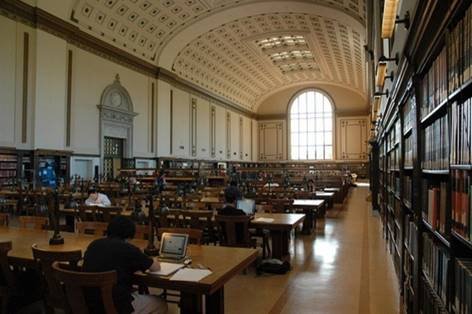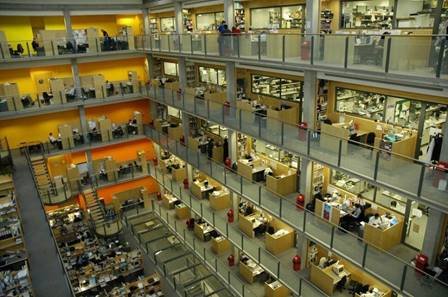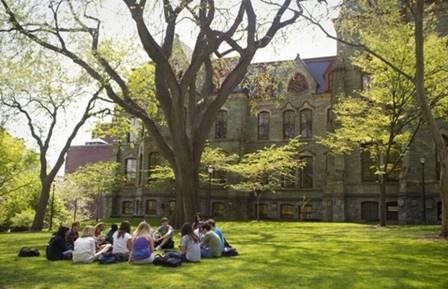TOP 10 BEST UNIVERSITIES IN THE WORLD
TOP 10
BEST UNIVERSITIES IN THE WORLD
Кудлай Х.П.
1. Harvard University
|
|
|
||||||||||||||||||||||||||||||||||||||
2. Stanford University
 Stanford University was founded in 1885 and is located in California’s Bay Area, around 30 miles south of San Francisco. Seven schools comprise the university, many of which are highly ranked for graduate-level studies. Three of the schools offer both undergraduate and graduate degrees: humanities and sciences; earth sciences; and engineering. The business, law, education and medical schools offer only graduate-level degrees. Stanford’s academic calendar is based on a quarter system and the language of instruction is English.
Stanford University was founded in 1885 and is located in California’s Bay Area, around 30 miles south of San Francisco. Seven schools comprise the university, many of which are highly ranked for graduate-level studies. Three of the schools offer both undergraduate and graduate degrees: humanities and sciences; earth sciences; and engineering. The business, law, education and medical schools offer only graduate-level degrees. Stanford’s academic calendar is based on a quarter system and the language of instruction is English.
3. University of California Berkeley
|
|
|
||||||||||||||||||||||||||||||||||||||
4. Columbia University
 Columbia University is a private institution that was founded in 1754. It is located in the Upper West Side of New York City’s Manhattan borough.
Columbia University is a private institution that was founded in 1754. It is located in the Upper West Side of New York City’s Manhattan borough.
Originally called King’s College, the school received its current name in 1896. Around 30 percent of students at Columbia study at the undergraduate level and almost 30 percent of the total student body is international. The university is made up of three schools that enroll undergraduates – Columbia College, the Fu Foundation School of Engineering and Applied Science, and the School of General Studies – and numerous graduate and professional schools. Among Columbia University’s highly ranked graduate programs are the Business School, the Law School, and the College of Physicians and Surgeons.
5. University of Cambridge
 The University of Cambridge, located around 60 miles north of London, traces its history back to 1209. Around 19,000 students attend the university and more than 35 percent of them study at the graduate level. There are six schools: arts and humanities; biological sciences; clinical medicine; humanities and social sciences; physical sciences; and technology. Cambridge has more than 100 libraries, including college and department libraries. The university has around 140 centers and institutes that contribute to different areas of research, such as the Centre of African Studies; the Cambridge Centre for Economic and Public Policy; and the Institute of Theoretical Geophysics. In a recent year, the university received around $415 million in research grants and contracts.
The University of Cambridge, located around 60 miles north of London, traces its history back to 1209. Around 19,000 students attend the university and more than 35 percent of them study at the graduate level. There are six schools: arts and humanities; biological sciences; clinical medicine; humanities and social sciences; physical sciences; and technology. Cambridge has more than 100 libraries, including college and department libraries. The university has around 140 centers and institutes that contribute to different areas of research, such as the Centre of African Studies; the Cambridge Centre for Economic and Public Policy; and the Institute of Theoretical Geophysics. In a recent year, the university received around $415 million in research grants and contracts.
6. University College London
|
universities around the world, such as the University of |
|
Montreal in Canada and Zhejiang University in China. |
 University College London, or UCL, is a public institution that was founded in 1826. It was the third university established in England, following the
University College London, or UCL, is a public institution that was founded in 1826. It was the third university established in England, following the
University of Oxford and the University of Cambridge. Additionally, UCL has exchange and research agreements as well as other types of partnerships with
University housing is guaranteed for first-year undergraduates. UCL has 11 academic divisions: arts and humanities; brain sciences; engineering; education; laws; life sciences; mathematical and physical sciences; medical sciences; population health sciences; social and historical sciences; and the Bartlett, a division focused on architecture and planning. The university is affiliated with several hospitals and medical centers, such as the University College Hospital and the Royal National Throat, Nose and Ear Hospital.
7. Yale University
 Yale University was founded in 1701, making it one of the oldest institutions of higher education in the U.S. The private university is located in New Haven,
Yale University was founded in 1701, making it one of the oldest institutions of higher education in the U.S. The private university is located in New Haven,
Connecticut, around 80 miles northeast of New York City. The university comprises the undergraduate college, the Graduate School of Arts and Sciences and numerous professional schools. Economics, political science and history are among the most popular majors for undergraduates. One of the major research innovations associated with Yale is chemotherapy treatment, which was developed at the university in the early 1940s.
8. Imperial College London
|
|
|
||||||||||||||||||||||||||||
9. University of California Los Angeles
 The University of California—Los Angeles, commonly referred to as UCLA, is a public institution that was founded in 1919. It is one of the most applied-to universities in the U.S. Undergraduate studies take place across five academic divisions at UCLA: letters and science; arts and architecture; engineering and applied science; nursing and theater, film and television. Some of the most popular majors for undergraduate students are political science, business economics and biology. UCLA has more than 350 research labs, centers and institutes, and nearly 300 of these facilities are dedicated to medical research.
The University of California—Los Angeles, commonly referred to as UCLA, is a public institution that was founded in 1919. It is one of the most applied-to universities in the U.S. Undergraduate studies take place across five academic divisions at UCLA: letters and science; arts and architecture; engineering and applied science; nursing and theater, film and television. Some of the most popular majors for undergraduate students are political science, business economics and biology. UCLA has more than 350 research labs, centers and institutes, and nearly 300 of these facilities are dedicated to medical research.
10. University of Pennsylvania
|
|
|
||||||||||||||||||||||||||||||


про публікацію авторської розробки
Додати розробку




